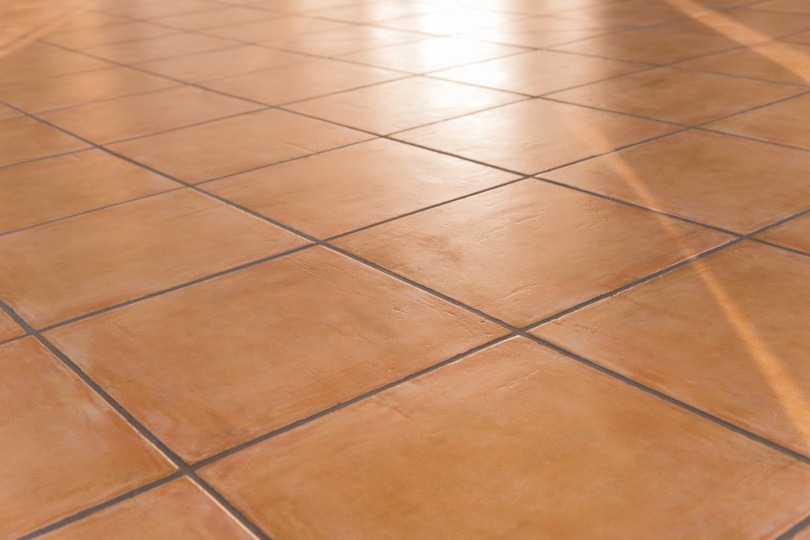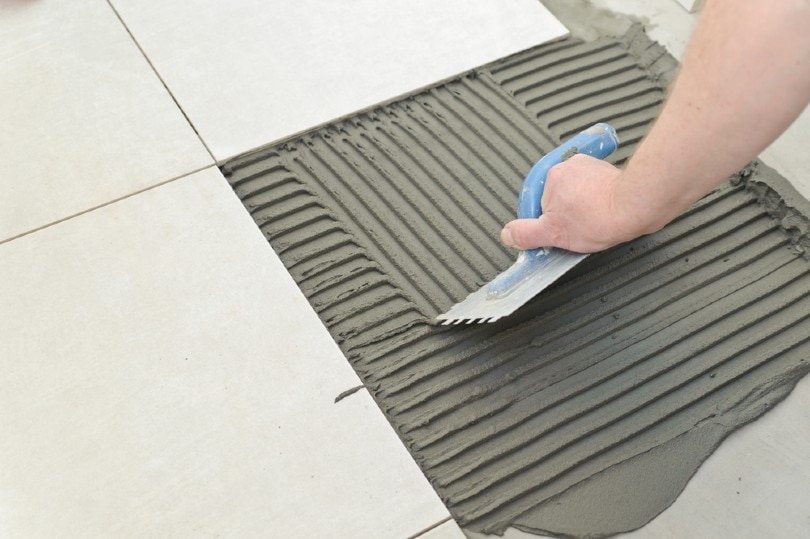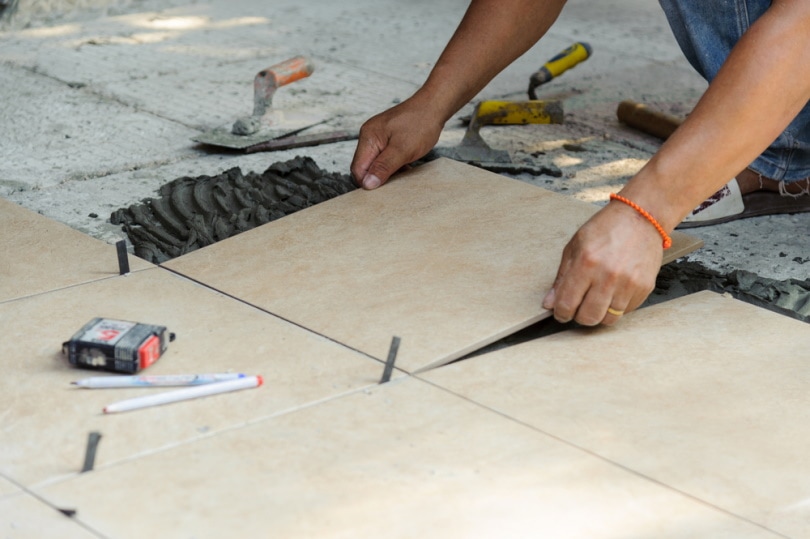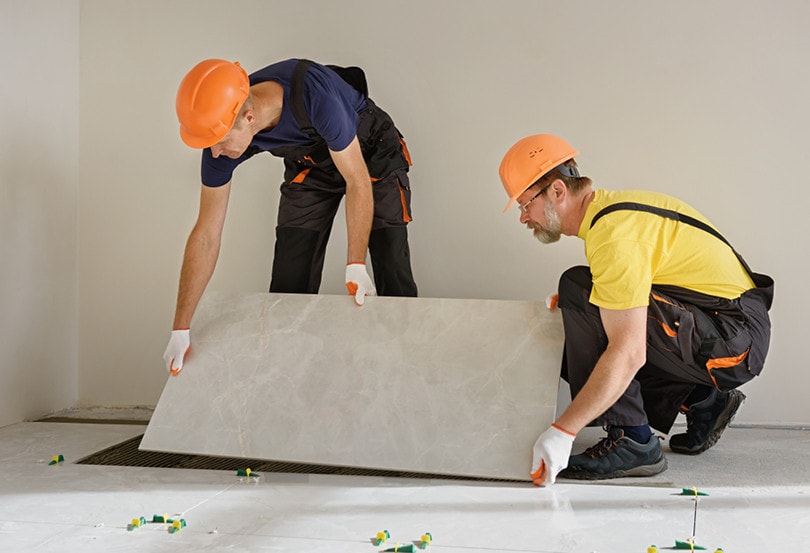How Thick Are Floor Tiles? Types, Sizes & FAQ
-

- Last updated:

If you are planning on redoing your flooring, one of the things that must be considered is the thickness of the new flooring. Floor tiles come in a variety of thicknesses that can range anywhere from just a couple of millimeters up to a full inch thick. Choosing the correct thickness for your project is important. It is also important to know how thick your floor is and how tall the floor is going to be at the end of the project. That may not sound like an important detail, but the height of your floors can affect everything from transitions to baseboards, trim, and your doors.
How thick are common floor tiles? Does it really matter? Is there a big difference in thicknesses? This quick overview aims to answer all of those questions and more. By the end, you should have the information you need to choose the right floor tile for your next project while taking the necessary considerations to ensure your project comes to a smooth and satisfying conclusion.
 Common Floor Tile Thicknesses
Common Floor Tile Thicknesses
The typical thickness of common floor tiles is determined by the size of the floor tile and the type of floor tile. Small tiles, like the ones used in backsplashes, mosaics, or accent pieces, are often thinner than large or wide floor tiles used as the main body tile. The material that floor tile is made out of will also determine what the average thickness of the tile will be. The thinnest floor tiles are vinyl tiles, while the thickest tiles are porcelain.
Most common floor tiles will measure between one-quarter and three-quarter inches thick. Floor tiles can measure 1/4, 3/8, 1/2, 5/8, or 3/4 inches thick. Occasionally you will find tiles that are thinner than that, such as vinyl tiles. Other times you might find large floor tiles that measure 1 inch or 1-1/4 inches thick. Large floor tiles used for commercial spaces or special stone tiles have a higher chance of being thicker than 3/4 inches.

Typical Thickness by Type
| Tile Material | Typical Thickness |
| Ceramic | 1/4 – 1/2 inch |
| Porcelain | 1/4 – 3/4 inch |
| Vinyl | 2mm – 8mm |
| Slate | 1/4 – 1/2 inch |
Floor tiles can measure anywhere from 2×2” up to 36×36” in size. The smaller the tile in terms of surface area or square footage, the thinner the tile generally is. Rarely will you find a large 24×24” tile that is 1/4 inch or thinner. Similarly, you will rarely find small 4×4” tiles that are more than 1/2 inch thick.
If you are planning on using multiple tiles of different sizes or brands, make sure they match up in terms of thickness. If you are trying to use a stone tile border that measures 1/2 inch thick, but the field tile you have chosen for the rest of the room is 3/4 inches thick, then you will have a 1/4-inch gap between your border tile and your field tile. That will be noticeable.
Tile Thickness by Size
| Tile Size | General Use | Typical Thickness |
| Tiny | Mosaic, backsplash, accent | 2 mm – 8 mm |
| Small | Border, bathrooms | 1/4 inch |
| Medium | General flooring, bedrooms, hallways | 1/4 – 1/2 inch |
| Large | General flooring, kitchens, living rooms, basements | 1/2 – 3/4 inch |
| Extra Large | Pavers, large rooms, commercial spaces | 5/8 – 1+ inch |
When buying floor tiles make sure that all the thicknesses match up and that the thickness is suitable for what you need. Thinner tiles usually have lower durability than thick tiles. Thick tiles should be used in high-traffic areas such as the kitchen, living room, and main entryway. Thinner, more decorative tiles can be utilized in lower-traffic areas such as a guest room or an out-of-the-way half bathroom.

Millimeters vs. Inches
Some floor tiles are measured in millimeters (mm), and others are measured in inches. Generally, thinner floor tiles are measured in millimeters, while thicker floor tiles are measured in inches. For example, 1/4-inch equals 10 mm. Some tiles, like vinyl, are consistently thinner than 10 mm meaning they are less than a quarter of an inch thick.
Some people say that you should never use any floor tiles under a quarter of an inch, but sometimes you will find tiles for accents or tiles that are designed to be put over other tiles that are slimmer than that.
Don’t Forget About the Underlayment
When considering tile thickness, do not forget about the underlayment. Tiles are not installed straight onto the subfloor. Many tiles need a leveling compound or adhesive. Some tiles need special backers to be installed properly. Some tiles need a moisture barrier. All of those things add height to a tile that will ultimately add to the overall thickness of the floor.
For example, if you have a 5/8-inch-thick tile and a 1/8-inch-thick underlayment, that can drastically change the complexion of the floor. An eighth of an inch might not sound like much, but it adds up. A tile that is 5/8 inch thick plus 1/8-inch underlayment equals 6/8 of an inch. If we boil that down, we get 3/4 of an inch. Anyone who has worked in construction knows that the difference between 5/8 and 3/4 is considerable. It will be noticeable on your floor.
Before choosing a tile thickness, make sure you are also factoring in any sort of backer, adhesive, or underlayment that might be needed to install the tile. Carefully check the installation requirements before buying, and make sure you understand the full height of the floor rather than just the thickness of the tile.

Why Does Floor Tile Thickness Matter?
Is all this talk about tile thickness, underlayment, and floor height important? Is a small difference in height that big of a deal? Why does floor thickness even matter? Most people do not think about the height of their floors or the thickness of their tile, but it is very important. The height of the floor affects the baseboards, floor transitions, and doors in your house. Getting a floor that is too high or too low can have adverse effects on some of the most basic things in your housework.
One of the biggest considerations is the baseboards in your house. If you replace your floor with a lower floor, there is going to be a gap between the bottom of your baseboards and the floor. This is usually fixed by installing quarter-round or shoe molding. This can cost anywhere from $0.15 to $0.75 per foot and can quickly add up to a large bill if you are not careful.
If you install a floor that is too tall, you will overrun your baseboard and need to remove them and reinstall them or replace them completely. That can result in another costly bill and a lot of additional labor.
Similarly, if you have a floor that is higher or lower than before, you might need to redo your floor transitions. If you change the height of your kitchen floor, for example, any borders touching other rooms with the old floor will need a new transition to account for the difference in height.
One of the most frustrating things to encounter with new floors if you raise them too much is running into doors that will not open properly. If you raise your floors too much, they will touch the bottom of your doors, and that can cause them to stick, scrape, or get stuck. That can happen if you add just half an inch of height to your floor and is mostly encountered when installing vinyl overtop existing tile.
 In Conclusion
In Conclusion
Typical floor tiles will usually measure between 1/4 inch and 3/4 inch in thickness. Anything thicker than 3/4 inch is usually a specialty product or something that is used for outdoor or commercial applications. Anything thinner is usually vinyl or covering tile. Be sure to look up how thick the underlayment or backer is before settling on a final decision. The final height of your floor is an important consideration that needs to be kept in mind from start to finish.
Featured Image Credit: Gordine N, Shutterstock
Contents
 Common Floor Tile Thicknesses
Common Floor Tile Thicknesses